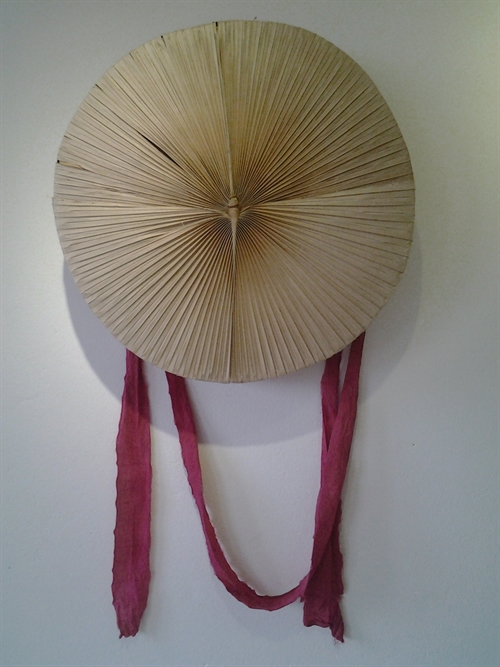 Features
Features

Before the mid-20th century, Nón ba tầm and other hats with big rims were common in the literature, photos and art from Northern Vietnam, however, since 1940 they have all but been replaced by the ubiquitous conical hat, and few even recognise their names anymore.
 |
| Wide brim: A woman wearing an ancient hat in a photo taken in early 20th century by the French. - Photo courtesy of Quang Thắng |
Before the mid-20th century, Nón ba tầm and other hats with big rims were common in the literature, photos and art from Northern Vietnam, however, since 1940 they have all but been replaced by the ubiquitous conical hat, and few even recognise their names anymore.
by Quang Thắng
Since 1940, conical hats originating from the central region have overwhelmed the country. Nón ba tầm and other hats with big rims have gradually disappeared in the North.
In thousands of photos and hundreds of paintings made by the French on daily life in the Northern delta at the end of 19th and early 20th century, we can see hats made from leaves everywhere.
Hats at that time were diversified in form, but the most popular were hats with big round rims and as flat as baskets holding silkworms.
The hats were associated with women in daily life at home, at markets, in paddy fields, by their sewing frames and at festivals. In many places, the white flat rims were distinguished, like a typical cultural feature of the region. They are nón ba tầm.
In the book titled Technique du peuple Annamite (Techniques of Vietnamese People), published in 1909, the explanation said: hats for women, called ba tầm. The word tầm here refers to the size of the hat.
In another book titled Connaissance du Việt Nam (Knowledge of Việt Nam), 1954, the writer explained: nón ba tầm, trois fois 8 pouces (1.20m)" (hat of three tầm: three times of 8 inches (1.20m).
I asked some hat makers in Thanh Oai District in the western outskirts of Hà Nội, who have maintained making ancient hats. They all confirmed: “the word ba tầm refers to the measurement of the hat rather than the number of leaf layers the hat is made of".
They further said that such a hat is made of two layers of leaves. Some hats have one more layer in the middle of two layers of leaves. The middle layer was mo nang (the outer skin of bamboo shoots) to make the hat stronger.
I don’t really understand the 1.20m measurement. I think ba tầm refers more to a bigger measurement than a concrete size.
Misunderstandings of the hat
Today, few people can distinguish between nón ba tầm and other kinds of hats with broad rims. Since 1940, conical hats, or hats originating from the central region, from Huế, became popular throughout the country. Nón ba tầm and other hats made of palm leaves with broad rims almost disappeared in the North. Many villages quit their traditional handicrafts of making hats.
The next generations have only been able to hear nón ba tầm and nón thúng (hats in the shape of baskets) in folk verses or tales told by old people.
Nón thúng has always been miscalled nón ba tầm, as they were also popular in the north.
Nón thúng has a big round rim the same as nón ba tầm, yet it has a deeper middle. The edge of nón thúng is softer and rounder rather than being straight like nón ba tầm. It was called nón thúng as it really does look like a thúng (basket).
 |
| Old yet new: A hat made recently in style of an ancient "nón ba tầm" by artisan Nghiêm Phú Luận, from Tri Lễ Hat Making Village, Thanh Oai District, on the outskirts of Hà Nội. - Photo courtesy of Quang Thắng |
Many people are also unable to distinguish nón ba tầm from nón quai thao.
Nón quai thao is actually a common name rather than depicting a particular kind of hat.
Earlier, people named hats according to their forms: nón ba tầm, nón thúng, nón lòng chảo (hats that look like saucepans), nón bứa (hats look like brindleberry) and nón chân tượng (hat that looks like the leg of an elephant).
Other kinds of hats were named after the people using them. For example, nón thầy tu (hats of monks), nón thủy thủ (hats of sailors), nón lính tập (hats for junior soldiers), nón kị mã (hats for horse riders). They were hats with the same form, but could be of different sizes.
Nón ba tầm with large diameters of up to 70cm were called nón mười. Nón ba tầm with a deep body and high edges were used at important events, while lower edged hats were used when working and trading at markets.
People did not distinguish hats according to their strings, as the strings could be taken out. Hats and strings were produced and exchanged as two different items. At first, the string was made of bamboo, then it was replaced by cloth or silk.
Quai thao is a kind of string for hats made of special silk by workers from Đơ Thao Village, Triều Khúc Commune, on the western rural district of today’s Hà Nội. The string was weaved and dyed very carefully and turned into a high-ranked kind of hat string. The string actually cost much more than the hat itself.
Quai thao was used with many kinds of luxurious hats like hats for brides, hats for monks (in black), nón ba tầm, nón thúng for women from wealthy families or ordinary women at special events like festivals and weddings.
So, quai thao could be used with different hats. The most popular was quai thao worn with nón ba tầm.
Nón thúng quai thao and nón nghệ (hats originating from Nghệ An) have been popular in folk songs:
Cô kia nón nghệ quai thao
Chồng cô đánh giặc biết bao giờ về
(For whom is that young woman wearing a Nghệ An hat?
Her husband is not expected to return from the battlefield any time soon)
Or
Chưa chồng nón thúng quai thao
Chồng rồi nón rách, quai nào thì quai
(Single women wearing nón thúng with luxurious strings
Married women wearing torn hats, not caring about the strings)
So why does quai thao appear so often in folk songs and verses?
As I mentioned earlier, quai thao was something like special jewellery. Because the string was made with great care and skill, it was even more striking than the hat. Because of that feature, nón quai thao has turned into a concept meaning valuable or festive hat and started being featured in folk literature as such. More than that, it was a metaphor for female beauty.
Nón quai thao has been part of the popular costume for young women at festivals while nón ba tầm are common for elder women while working. — VNS









